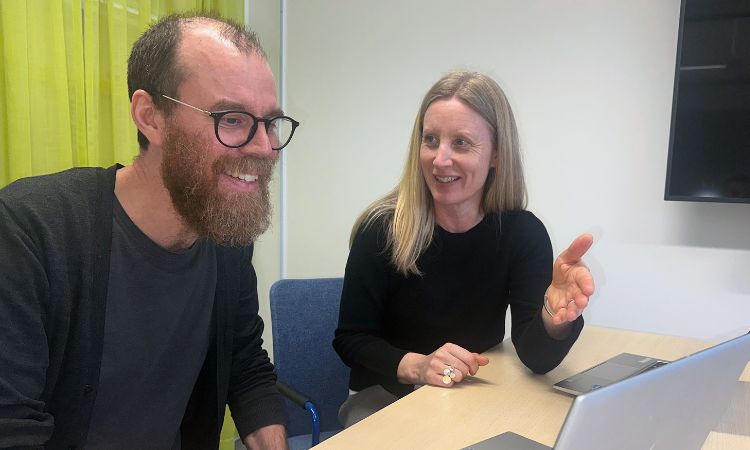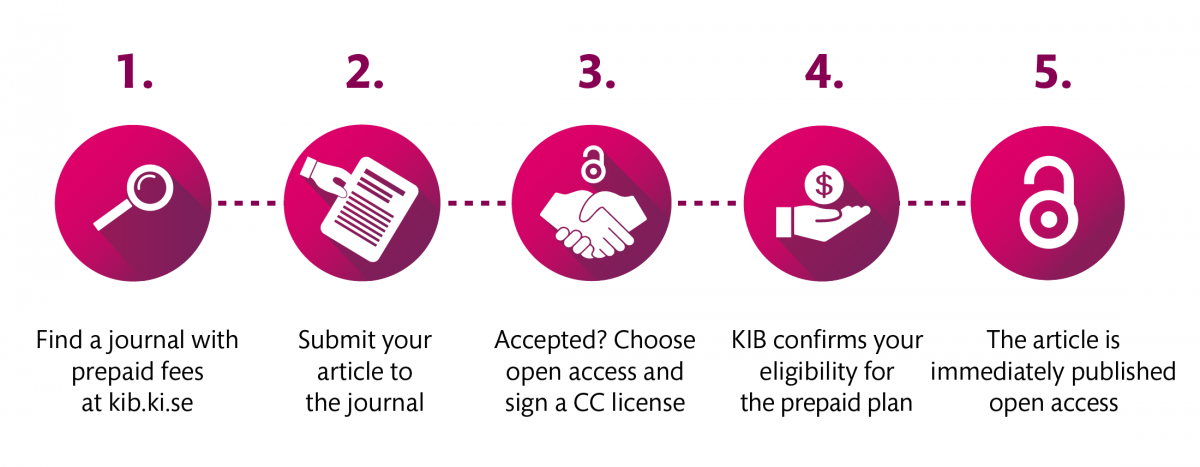Different ways of publishing open access
According to KI’s policy for open access, researchers at KI have to make their peer reviewed publications openly and freely available. This should be done immediately, at the time of publishing when possible. This can be achieved by either publishing the article open access in a journal or by self-archiving the manuscript in an open archive.
Publish your article open access in a journal
Open Access/APC Checker Tool
In Open Access/APC Checker Tool you can search for a specific journal title to see if it is included in an open access agreement with prepaid publishing fees/APC:s. If a journal is included you will find a link to the publisher and information on how to publish under the agreement.
Terms for all the agreements:
- You need to be the corresponding author.
- You need to be affiliated with KI and you should also state this in the article.
- The research should have been predominantly conducted at KI.
- Use your email address ending with @ki.se and enter Karolinska Institutet as your institution to facilitate identification.
A quick guide – publish your article open access in a journal
Use the search box above to find a journal with prepaid publishing fees. Please follow the link in the search result to read more about what's included in KIB's agreement. The next step is to submit your manuscript to the journal. Remember to use your @ki.se address and that you need to be the corresponding author and affiliated with Karolinska Institutet. After the article has been accepted, choose open access publishing and sign a Creative Commons license. Lastly, the University Library confirms that you are eligible for the prepaid plan. As a result, your article is immediately published open access.
How can I find out if a specific journal is part of an open access agreement with prepaid APC's? You can search for journals in the Open Access/APC Checker Tool. If you find the journal you also find more information about the agreement for that particular journal.
I can't find the journal that I want to submit my manuscript to, what then? You could always double check with the library, we strive to keep the APC Checker Tool fully updated, but there are frequent changes to the titles included. If the journal is not included in any of the agreements you can choose to publish your article behind paywall or pay the APC yourself if the journal offers open access publishing or you can self-archive the article.
What do I need to do to take part in the agreements? You can see what requirements there are for each agreement.
How do I know which license to choose? In the open access policy at KI the CC BY-license is recommended. You can see which licensing options each publisher offers on the agreement pages. You can also read about what the different licenses mean. You can usually choose which license you want to use.
I don't understand what I need to do to avoid paying the APC myself? Each publisher has their own workflow for publications and each publisher often have very useful author guides that will help you through the process. You can also contact the publisher if you have questions or contact us at the library and we will help you.
Why do I need to use my KI email address when submitting my manuscript to the publisher? It facilitates for the publisher to identify you as affiliated to KI. This means you get in the right track from the beginning, making the whole process easier.
I have received an invoice for "page charges"/"colour charges" or something similar, should I have to pay that? It is not uncommon that publishers take extra charges for colour prints and the like. These charges are typically not included in the agreements and will have to be paid by the author.
Is it easier to get an article published in an open access journal than in a subscription journal? The short answer is no, please read about the benefits of publishing open access earlier on this web page.
Self-archiving of a manuscript in an open repository
Many journals allow you to self-archive a version of your article in an open repository (green open access). Self-archiving may be subject to some form of restriction, usually an embargo period of six months or more. Which manuscript version the journal allows you to self-archive may also vary. The peer reviewed and final version of the article, the Author’s Accepted Manuscript, AAM, (also called postprint) is the version that you as a KI researcher should use for self-archiving in accordance with KI’s Policy for open publishing. This is also the version that most research funders and Plan S approves of. The Open policy finder database provides information on any restrictions.
KI's open repository is called KI Open Archive. Find more information on how to self-archive your manuscript (or the published article if the publisher permits this) on the page Manage your publications in KI RIMS, under the heading Self-archive articles in KI Open Archive via KI RIMS.
| Author's Accepted Manuscript (AAM) | The final author-created version of the manuscript, which includes any changes made after peer review and has been accepted for publication by the journal. |
| Article Processing or Publishing Charge (APC) | The fee the author pays for publishing the article open access. |
| cOAlition S and Plan S | An international consortium of research funding and performing organisations and an initiative for open access publishing. |
| Corresponding author | The author who takes primary responsibility for communication with the journal during the entire publication process. |
| Creative Commons license | An open license stating what others are allowed to do with a published article. |
| Diamond open access | Journals (or platforms) where there is no publishing charge and where all content is freely available to read. Sometimes also called Platinum open access. |
| Embargo period | The time period that an article is locked behind a paywall and only can be read by subscribers. |
| Green open access | The self-archiving of articles; the publishing of a version of the article in an open archive (often only allowed after an embargo period). |
| Gold open access | Publishing in a fully open and freely available journal where everything is free to read for everyone. |
| Hybrid journal | A journal that is a subscription journal (behind paywall) but where some articles are published open access (financed through APC:s). Also called hybrid publishing. |
| Open access journal | A journal where all articles are freely available for all to read, usually financed through APC's. Also called gold journals or gold publishing. |
| Pre-print archive | An online archive containing a version of scientific articles that has not been peer reviewed or accepted for publishing in a scientific journal. One example is arXiv.org. |

Publication support
Contact us with questions regarding open access, KI's publishing agreements, bibliometrics, publishing in KI Open Archive and strategic publishing.
If you would like us to get back to you, please submit your contact information in the form below along with your feeback.

